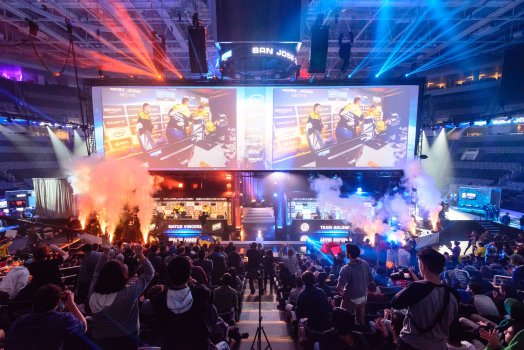
When it comes to e-sports, Dennis Fong considers himself patient zero — the first player to discover you can earn money playing video games. Before he ran services such as Plays.tvand Raptr, Fong (aka “Thresh”) was the world’s best “Doom” and “Quake” player.
“From the money perspective … I was the first one making a living at doing” e-sports, he said in an interview, talking about growing up in Los Altos and becoming a professional gamer. As the field’s first star, he helped establish e-sports as an underground niche and now is helping make it a burgeoning part of the video game industry.
Not only are e-sports televised today, but they regularly fill up venues used for NBA games — including Oracle Arena, where the Intel Extreme Masters event takes place this weekend.
“The IEM is the big one in the Bay Area,” said Michal Blicharz, vice president of pro gaming at the Cologne, Germany-based ESL, which organizes these competitions worldwide and backs a top league. “It’s the biggest e-sports event in the Bay Area and the biggest ‘Counter-Strike’ event in California,” added Blicharz.
The IEM in Oakland features competitions in two games, “League of Legends” and “Counter-Strike: Global Offensive.” The first is a multiplayer online battle arena where two teams of five control virtual champions with a variety of abilities. The goal is to destroy the rival’s base. The draw of “League” is the strategizing involved as teams try to outmaneuver and defeat their opponents. Since its 2009 release, “League” has become one of the pre-eminent e-sports titles.
“Counter-Strike,” introduced in 1999, also pairs off two teams of five people. One side represents terrorists guarding a bomb, the other counter terrorists intent on defusing it. This first-person shooter demands intricate team interaction. Matches become tense as one side picks off the other’s personnel until they are wiped out or the oposing team completes its objective.
Last year’s IEM drew 9,000 to 10,000 people over two days at SAP Center in San Jose, according to Blicharz. It also featured a charity event where billionaire Dallas Mavericks owner Mark Cuban played against Intel CEO Brian Krzanich in “League of Legends.” This year, said Blicharz, ESL is expecting a similar-size crowd, and it will also feature a twist onthe Big Game as teams from Cal and Stanford duke it out in a “League” show match.
As for the main competition, teams will battle for a $100,000 prize pot in “League of Legends” and $300,000 in “Counter-Strike.”
With its mix of tech innovation and history, the Bay Area is one of the few places in the U.S. that have become competition hubs. Blicharz says historically Dallas has been an epicenter, while Southern California has drawn teams and events thanks to Riot Games, the “League of Legends” developer based in Santa Monica, and Blizzard, the developer of e-sports games such as “Hearthstone,” “StarCraft” and “Overwatch,” headquartered in Irvine. Seattle is a hub because of its proximity to gaming giant Valve, which hosts the International, a tournament for the popular game “Dota 2.”

The Bay Area’s gravity stems from streaming giant Twitch and gaming and hardware companies, Blicharz said, including Electronic Arts (“Madden NFL”) and Capcom (Street Fighter”).
In a training facility at Logitech’s U.S. headquarters in Newark, pro players from Team Solomid and Cloud 9 practice for up to 12 hours a day, according to Brent Barry, the company’s head of e-sports. Then there’s the region’s demographic. “Lots of young people — lots of young people interested in tech, this kind of tech — is integrated in this part of the country,” he said. “Events like these naturally fit.”
Fong, who graduated from pro gamer to running companies that fuel interest video gaming, sees the same potential e-sports audience in the younger generation. “Today, I suspect if you were to talk to anyone under the age of 25, they would all know about e-sports,” he said. “It’s not mainstream yet, but anyone who has kids will see it.”
[Source:-The mercurry post]







